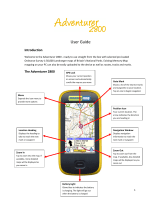
Table of Contents
Introduction.................................................................... 1
Device Overview........................................................................ 1
Battery Information..................................................................... 1
Installing the Battery Pack..................................................... 1
Installing AA Batteries........................................................... 2
Turning On the Device............................................................... 2
Setting Up the Device................................................................ 2
Using the Touchscreen.............................................................. 2
Home Screen............................................................................. 2
Viewing Notifications............................................................. 2
Enabling GPS............................................................................ 2
Updating the Device Software................................................... 2
Locking and Unlocking the Touchscreen................................... 2
Waypoints, Routes, and Tracks ...................................2
Waypoints.................................................................................. 2
Creating a Waypoint.............................................................. 2
Marking a Waypoint Using the Map...................................... 2
Finding a Waypoint............................................................... 2
Editing a Waypoint................................................................ 3
Deleting a Waypoint.............................................................. 3
Increasing the Accuracy of a Waypoint Location.................. 3
Projecting a Waypoint........................................................... 3
Where To? Menu....................................................................... 3
Optional Maps....................................................................... 3
Finding a Location by Name................................................. 3
Finding a Location Near Another Location............................ 3
Finding an Address............................................................... 3
Routes........................................................................................ 3
Creating a Route................................................................... 3
Editing the Name of a Route................................................. 3
Viewing a Route on the Map................................................. 3
Editing a Route...................................................................... 3
Deleting a Route................................................................... 3
Viewing the Active Route...................................................... 3
Reversing a Route................................................................ 3
Tracks........................................................................................ 4
Pausing Track Recording...................................................... 4
Customizing Your Track Log................................................. 4
Following Your Track Log..................................................... 4
Saving the Current Track...................................................... 4
Viewing the Elevation Plot of a Track.................................... 4
Changing the Track Color..................................................... 4
Archiving Saved Tracks........................................................ 4
Clearing the Current Track.................................................... 4
Deleting a Track.................................................................... 4
Garmin Adventures.................................................................... 4
Sending Files to BaseCamp.................................................. 4
Creating an Adventure.......................................................... 4
Starting an Adventure........................................................... 4
Navigation.......................................................................4
Navigating to a Destination........................................................ 5
Stopping Navigation.............................................................. 5
Navigating with the Map............................................................. 5
Navigating a Driving Route................................................... 5
Navigating with the Compass.................................................... 5
Calibrating the Compass....................................................... 5
Course Pointer...................................................................... 5
Navigating with Sight 'N Go....................................................... 5
Elevation Plot............................................................................. 5
Navigating to a Point on the Plot........................................... 5
Changing the Plot Type......................................................... 5
Resetting the Elevation Plot.................................................. 5
Calibrating the Barometric Altimeter..................................... 5
Trip Computer
............................................................................ 5
Resetting the Trip Computer................................................. 6
Photos and Video...........................................................6
Taking a Photo........................................................................... 6
Taking a Panoramic Photo.................................................... 6
Recording a Video..................................................................... 6
Viewing Photos and Videos....................................................... 6
Geocaches...................................................................... 6
Downloading Geocaches........................................................... 6
Filtering the Geocache List........................................................ 6
Creating and Saving a Geocache Filter................................ 6
Applying a Saved Geocache Filter........................................ 6
Editing a Custom Geocache Filter........................................ 6
Navigating to a Geocache.......................................................... 6
Logging the Attempt................................................................... 6
chirp™........................................................................................ 6
Finding a Geocache with a chirp Device............................... 7
Applications................................................................... 7
Installing Applications................................................................ 7
Setting a Proximity Alarm........................................................... 7
Using the Flashlight................................................................... 7
Calculating the Size of an Area.................................................. 7
Satellite Page............................................................................. 7
Changing the Satellite View.................................................. 7
Listening to NOAA® Weather Radio.......................................... 7
Listening to FM Radio................................................................ 7
Viewing Weather Data............................................................... 7
Customizing the Device................................................ 7
Adding Shortcuts and Widgets to the Home Screen.................. 7
Rotating the Screen................................................................... 8
Locking the Screen Orientation............................................. 8
Map Settings.............................................................................. 8
Custom Data Fields and Dashboards........................................ 8
Enabling the Map Data Fields............................................... 8
Customizing the Data Fields................................................. 8
Customizing Dashboards...................................................... 8
Tracks Settings.......................................................................... 8
Routing Settings......................................................................... 8
Changing the Units of Measure................................................. 8
Position Format Settings............................................................ 8
Heading Settings........................................................................ 9
Altimeter Settings....................................................................... 9
Proximity Alarms Settings.......................................................... 9
Connecting to a Wireless Network............................................. 9
Pairing Bluetooth® Devices....................................................... 9
Pairing Your ANT+™ Sensors................................................... 9
Enabling Airplane Mode............................................................. 9
Profiles....................................................................................... 9
Selecting a Profile................................................................. 9
Creating a Custom Profile..................................................... 9
Editing a Profile Name........................................................ 10
Deleting a Profile................................................................. 10
Sound Settings......................................................................... 10
Display Settings....................................................................... 10
Adding Accounts...................................................................... 10
Changing the Lock Screen Security......................................... 10
Language and Input Settings................................................... 10
Backing Up Your Data............................................................. 10
Resetting to Factory Defaults................................................... 10
Date and Time Settings........................................................... 10
Device Information.......................................................11
Battery Information................................................................... 11
Maximizing the Battery Life................................................. 11
Saving Energy While Charging the Device......................... 11
Table of Contents i


















